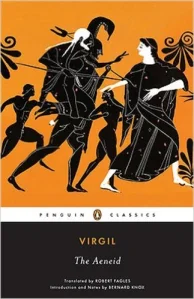 Book VI is the center of the Aeneid. Aeneas has completed the journey to Italy, but has not yet fought a war to establish a place for the Trojan refugees. Aeneas must descend into the underworld–the world of the dead–before he can acquire the knowledge to live in Italy. Or does he? Why does he return through the ivory gate–the gate of false dreams–rather than the horn gate–the gate of true dreams? This extremely philosophical and mystical book raises many questions.
Book VI is the center of the Aeneid. Aeneas has completed the journey to Italy, but has not yet fought a war to establish a place for the Trojan refugees. Aeneas must descend into the underworld–the world of the dead–before he can acquire the knowledge to live in Italy. Or does he? Why does he return through the ivory gate–the gate of false dreams–rather than the horn gate–the gate of true dreams? This extremely philosophical and mystical book raises many questions.
It is divided into three parts: Aeneas’ arrival at Cumae and preparations for the descent (1-263); the journey through the underworld to Elysium (264-678); and the interview with Anchises about the nature of life beyond the grave and the vision of greatness of Rome’s future through a pageant of Roman heroes (679-end).
 In Book VI Aeneas is entranced by two ecphrases and two gates.
In Book VI Aeneas is entranced by two ecphrases and two gates.
Are they dreams? Are they real?
In English literature, we take for granted many of the conventions of classical literature, among them characterization, plot, speeches, similes, metaphors, imagery, and symbols. We do not, however, commonly talk about ecphrasis. Ecphrasis is a Greek word simply meaning description, and is used in poetry to describe an artifact or work of art in such a way that it makes a meaningful comment on the text, or illumines it in some way. Virgil looked to the brilliant ecphrases in Homer’s Iliad and Odyssey for inspiration: Homer’s most famous ecphrasis occurs in Book 18 of the Iliad, a delineation of the engravings on Achilles’ shield, made by the god Haephaestus for Achilles. Virgil would also have been familiar with the ecphrasis in some lesser known ancient poetry, Apollonious’ The Argonautica, which describes details on Jason’s cloak. And Catullus in Poem 64 describes the detail on a coverlet. Ecphrasis is an epic convention, and of course Virgil has crafted many beautiful, vivid ecphrases in The Aeneid.
Aeneas lands at Cumae in Italy, the site of the temple of the Sibyl, Apollo’s priestess and oracle. The mention of Cumae would have evoked recognition, due to Augustus’ recent restoration of the temple.
On the doors of the temple are Daedalus’ (mythic) engravings; the Sibyl immediately tells Aeneas not to linger. Why? Is it too dream-like? Is the underworld more real?
Non hoc ista sibi tempus spectacula poscit. (37)
“This time does not demand those sights you are gazing on.” (This is not the time for sighteseeing.)
Daedalus’ engravings of the labyrinth, the death of Minos’ son, and the Minotaur are an ecphrasis, such as we saw in Book I. There Aeneas was overcome by depictions of the Trojan War on the walls of the temple of Juno, but here we do not feel that emotion. Here the engravings are more remote, mysterious, and we also see the absence of a portrayal by Daedalus of his son Icarus’s death. Some believe that this absence of the son in the engravings is a kind of reversal of the absence of Aeneas in Anchises’s underworld: Daedalus’s son is dead, presumably in the underworld; Aeneas’ father Anchises is dead, in the underworld.
After prayers, sacrifices, and the funeral proceedings for Misenus, who has died seemingly at random, reminding us of the brevity of life, is the mystery of what Aeneas is about to undergo, a visit to death and return. Aeneas breaks off the golden bough, a symbol of life and death. He needs the bough to enter the underworld. And it immediately grows back on the tree.
Part 2: The Journey
Virgil has drawn on material from the 11th book of the Odyssey, Odysseus’ visit to the underworld. He also refers to Plato (the Phaedo, the Republic, etc.), Cicero’s Dream of Scipio, and even Aristophanes’ comic riffs on heroes in the Underworld, The Frogs.
He meets three ghosts: Palinurus, a Trojan helmsman who was swept overboard by the god Sleep near the end of the journey to Italy and cannot cross the Styx–Aeneas feels guilty; Dido, who will not speak to him and glides away, despite Aeneas’s begging for forgiveness; and Deiphobus, a Trojan hero, Helen’s second Trojan husband after Paris’ death, who was killed by her bloody betrayal to Menelaus. Aeneas is sorrowful and desolate, but he cannot change things. This is especially brought home to him by Dido, who now coldly rejects him just as he rejected her.
3. The Revelation
The last section is connected with the glory of the future. After passing the hell of Tartarus and arriving at the heaven of the Elysian fields, Aeneas and the Sibyl meet some Trojan heroes, warriors, and singers who are pursuing the occupations they followed in life. But Anchises is entertaining himself by counting the descendants of the Roman race. And this is the second ecphrasis in Book VI.
Anchises describes to Aeneas a veritable pageant of Roman heroes who will reward Aeneas’s journey to Italy. Among the Roman heroes are Romulus, the Roman kings, Cato, the Gracchi, Augustus, Caesar, Pompey, and Marcellus.
Anchises’ magnificent visual art-ecphrasis of the future restores Aeneas’ courage. He now understand that there is a purpose to the journey and to the war he must fight in Italy to win a place for the Trojans.
But there are two gates out of the underworld, the horn gate, the gate of true dreams, and the ivory gate, the gate of false dreams. Aeneas and the Sibyl return to Cumae through the ivory gate–the gate of false dreams. Perhaps the dreams of an empirical future will not after all repay Aeneas’s loss of his personal life.
Virgil describes the two gates (literal English translation below the Latin):
Sunt geminae Somni portae, quarum altera fertur
cornea, qua ueris facilis datur exitus umbris,
altera candenti perfecta nitens elephanto,
sed falsa ad caelum mittunt insomnia Manes.
his ibi tum natum Anchises unaque Sibyllam
prosequitur dictis portaque emittit eburna…
“There are twin gates, of which one is said to be horn, by which an easy exit is given to true shades, and the other is made shining of white ivory, but Hades sends false dreams through this gate to our world. Anchises, having finished speaking escorted his son and the Sibyl and sent them out by the ivory gate.” (My literal translation.)



















